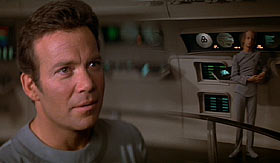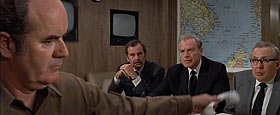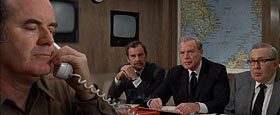
Dan's Data letters #155
Publication date: 24 November 2005.Last modified 03-Dec-2011.
Spatial anomalies
So I was watching Star Trek: The Motionless Picture the other day, as you do, and I noticed that some scenes look really weird. No, not the cheesy 1979 SFX, the ones where there's something in the foreground in focus on one side of the screen, and something in the background in focus on the other side, and a weird blurred part in the middle.
It looks as if they used two cameras and fuzzily spliced the results together. I can't remember seeing this in any other movie. What is it?
Henry
Answer:
It's where Robert Wise, the recently deceased director of ST:TMP,
used a "split dioptre" lens ("split diopter", outside the
Commonwealth). One half
of the lens focuses at one distance, the other half focuses at the other, and in between you get an unsightly fuzzy
effect. Which could have been digitally painted over for the 2001 DVD version of the movie, but wasn't.
The effect's particularly noticeable in this bridge scene, where it keeps that piercing-eyed, high-foreheaded alien bridge crew dude whose race probably has a name starting with T in sharp focus every time the scene cuts back to Kirk.
Aha, the audience says, that funny-looking guy must be up to something sinister.
As it turns out, though - he's not. He doesn't even get any more lines in the movie. The director just decided to let everybody look at him for a while instead of framing the shot differently, or leaving half of the frame blurry.
You won't see the fuzz in a split-dioptre shot if there's no detail in the middle of the frame, which in some shots there isn't. If there's a bug on a twig in the foreground to the left and David Attenborough in the background to the right, and nothing but sky or already-fuzzy far-background jungle in the middle, split lens weirdness will be invisible. It's particularly noticeable in TMP, though, because Wise kept using it in close-quarters indoor shots with lots of stuff, or even actors' limbs, in the middle of the frame.
The usual reason why directors use split dioptre is that it lets you use a lens with a large aperture - to let in lots of light - and still manage something resembling good depth of field. The ST:TMP sets weren't very brightly lit, though explanations vary as to why - perhaps because the sets were pretty small and they didn't want the actors to die of heat prostration, and perhaps also because the "computer displays" weren't very bright. The displays were all backlit cels, rear-projection and dinky little light bulbs, which would have been washed out on a brightly lit set.
Whatever the reason, the dim light, combined with the lousy sensitivity of the film available at the time, meant they had to use large lens apertures (and even then, it often looked pretty gloomy on the bridge of the refit Enterprise). Large aperture means small depth of field, which makes it hard to get two people in focus at once unless they're standing in the classic Soap Opera Configuration, all in a line equidistant from the camera and partly turned toward it.
Robert Wise used split lenses quite often - you can see the effect in The Hindenburg and The Andromeda Strain too, for instance.
This shot from The Andromeda Strain works well - there's not that much blur in the first place (presumably because the scene's more brightly lit and the aperture can therefore be smaller), what blur there is is lost in the back wall, and even the arm stretching across the frame looks OK.
A moment later, though, something strange has happened to the lower end of the phone cord (it's more obvious if you click the thumbnail to get the full-sized image).
In modern film split lenses are seldom necessary any more, but they're still occasionally used for effect. Quentin Tarantino used one in Reservoir Dogs, when the mutilated policeman's talking to the more seriously injured Mr Orange in the background, with both of them in focus and the trademark area of weirdness in between them.
(I think it's more likely Tarantino was paying homage to Brian de Palma there, rather than Robert Wise.)
Split dioptre lenses are also used in still photography; they can be had as screw-on filters for various still and motion picture camera lenses, as well as whole separate lenses. One big split dioptre market - which is to say, it's big by the standards of strange-niche-lens sales - is for underwater photography, when someone wants to take one of those tricky half-underwater shots with the waterline through the middle of the frame, without cheating and just assembling the shot in Photoshop.
Oh, and if you were watching the 2001 DVD version of TMP, some of the "70s" effects were actually, um, "noughties" effects. I'm not entirely without sympathy for people who think the movie could have been tightened up a bit (by, for instance, restricting the cast to only one astonished reaction shot every five minutes each), but I think the remastered TMP still hangs together very well. The new FX don't stick out compared with the old ones, and those short of patience are amply warned by the fact that the film opens with a few minutes of peaceful music and Windows Starfield screensaver.
The new Motion Picture compares very well with certain "improved" films that're full of fancy CGI beasties until you get to the end, and then suddenly everyone's flying over a bunch of grey-painted Tupperware again (don't get me started...).
"Ours go to 11!" "WHAT?"
Being an audiophile (though not the type that spends outrageous sums of money on special cables), I would like to protect the most important part of my audio system - my ears. I enjoy listening to DJs at rather large events and clubs where the music is pounding at insane dB levels. What hearing protection would you recommend that is realistic for these environments (my squishy yellow foam plugs really distort the sound, and I would love to move away from them if possible)?
I found the Elacin ER20s online, but was curious as to your take and any other options before I drop any money on them. Also, as I am an up-and-coming DJ, the protection would need to fit under headphones for mixing.
Second, I do suffer from mild tinnitus (ringing in the ears). It is very mild and have had it ever since I can remember. While Googling (yes, I do use it as a verb) for "hear protection" I found this, and my Quack Sense started tingling. Their studies and research data are posted. Some of them look pretty good (PDF), but I wanted to run this by you first. A quick Googling of them didn't really show too much beyond the normal forum babble.
Nathan
Answer:
I use squishy peach foam earplugs
when sleeping.
The slight colour difference really enhances the air and musicality of midrange transients.
Foam earplugs attenuate high frequencies more strongly than low, which is why they're not very good when you're listening to music. Industrial earmuff hearing protectors, which of course no sane person would be wearing at a gig anyway, exhibit similar behaviour, except they typically have a resonance in the low midrange that means their attenuation at, say, 250Hz isn't quite as good as at 125Hz and 500Hz.
I haven't auditioned earplugs for music purposes, but other people have. It looks as if you should try rubber earplugs, quite possibly the fancy silicone Elacin ones, if you're not crazy about dropping big dollars on the real-deal custom-fit plugs made for the people on the stage.
The laser-tinnitus-cure peoples' studies do indeed look good, until you try to find what peer reviewed journal - or, um, any other journal - said study was published in, and fail. The Medline database indexes every reliable medical journal and a lot of dodgy ones, but there's no sign of this study in it.
When I read studies like this, there's a little song I sing, to the tune of Cold Chisel's "Saturday Night":
"Making stuff up, doo doo dooo doo dooo doo doo doo doo doo..."
(Actually, those aren't the exact words I sing.)
There have, to be fair, been a few other real published-somewhere studies of low-power laser irradiation for treatment of tinnitus. This one, for instance, found it was useful. This one found it was useless, despite using a big hairy 60mW laser, instead of the crummy little pointer-laser that tinnitool.com wants to sell you.
I think lasers in modern quackery are not unlike electricity in old-time quackery; they're a cool weird phenomenon that freaks people out, so dodgy practitioners fall on them with glee as a great way to convince the rubes that something cutting-edge and amazing is being done to them, resulting in excellent placebo response. Lots of quacks today are shining little diode lasers on various parts of people to treat various ailments, and I'm sure not all of their patients leave unsatisfied.
(Magnetism, in contrast, is a hardy perennial in the quack arsenal; it's still popular in umpteen worthless products and treatments today, even though people have been making medical claims about magnets since about five minutes after the first guy wearing an animal skin discovered the first lodestone.)
Burping batteries
Here's something that caught my eye... a new battery charging method using negative pulses!?
I haven't heard of something like this before. I have heard of pulse charging, but not negative pulse charging.
What do you think... useless BS or something usefully?
Mike
Answer:
It's not new, and it's not particularly useful, either.
In The Beginning, people made variable-rate chargers for NiCds (NiMH cells didn't exist yet) that only had one actual current setting, but varied their duty cycle - so if you asked for 2.5A from a charger with a 5A maximum rate, for instance, it'd just pulse its output so that half of the time it was delivering 5A and the other half of the time it was doing nothing. The pulse rate was, and is, often not terribly fast - a few times a second at most.
This technique makes chargers cheaper and works just fine (though, contrary to some manufacturers' claims, it's not actually notably better than charging at a steady rate equal to the average output of the pulsed charge), but some people got it into their heads that you could charge faster, or prolong the useful life of the batteries, or get more starting punch out of your R/C car, or whatever, by actually discharging the battery in pulses in between the charge pulses. That's reverse pulse, or "burp" charging, and it's basically just voodoo. It does no harm, but it also does no good, as far as I know.
Here's more info.
What if you drink red wine while using the phone?
I read what you said about mobile phones, and was wondering what you make of this (among other sites).
There seems to be a lot of evidence about acoustic neuroma and analogue phones, and I thought digital would be worse, with the wider bandwidth it has for the carrier.
Michael
Answer:
Well, there's that one retrospective epidemiological study, indexed in Medline
here;
assuming it's kosher, it's your standard 95% confidence interval study, so there's one chance in twenty that it got
its results by chance.
While we're playing Duelling Abstracts, though, this larger study says pretty much the opposite. Likewise this one.
This review of nine other studies, though, admits that they're not terribly good, but says that acoustic neuroma risk, in particular, is higher.
But this review of studies of RF and cancer in general, not phones and acoustic neuroma in particular, says most of them are lousy and no firm conclusions drawable, though further-research-is-needed, as usual.
Asymptomatic acoustic neuroma is apparently somewhat common (though we only know about it thanks to autopsies); of course, it's arguable that an asymptomatic illness that won't kill you isn't actually an illness at all.
The highest estimates of acoustic neuroma's prevalence in the general population say that one in 3500 people have it. So even if some behaviour doubles your chance of getting it, that's not a big risk. The lowest prevalence estimates are one in a million; double that likelihood and it's still not worth worrying about.
But wait - there's more! Click here to go to page 2 of this letters column!




